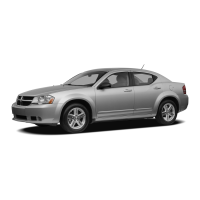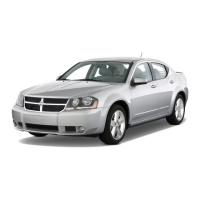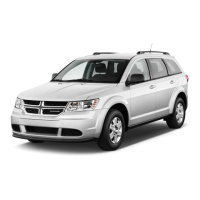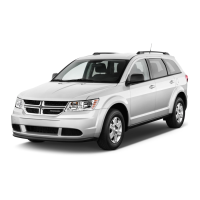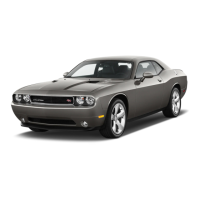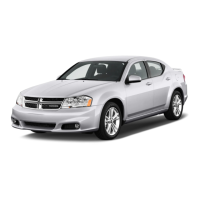
Do you have a question about the Dodge Avenger 2012 and is the answer not in the manual?
| Brand | Dodge |
|---|---|
| Model | Avenger 2012 |
| Category | Automobile |
| Language | English |
Congratulations on selecting your new Chrysler Group LLC vehicle. This manual acquaints you with operation and maintenance.
Manual contains warnings for collision/injury and cautions for vehicle damage. Observe all Warnings and Cautions.
Modifications can affect roadworthiness and safety, potentially leading to serious injury or death.
Immobilizer system prevents unauthorized operation by disabling the engine. Operation is automatic.
Monitors doors/trunk for entry and ignition for unauthorized operation. Interior switches disabled when armed.
Lock/unlock doors, open trunk, or activate Panic Alarm from approx. 66 ft (20 m).
Starts engine conveniently from outside vehicle using RKE transmitter. Range approx. 300 ft (91 m).
Do not allow children access to trunk. Always close trunk lid when vehicle is unattended.
Three-point lap/shoulder belts, Advanced Front Air Bags, Active Head Restraints, Side Air Bags.
Advanced Front Air Bags supplement seat belts. Driver's bag in steering wheel, passenger's in instrument panel.
Designed to provide additional protection in frontal collisions, supplementing seat belts.
Do not modify system components or wiring. Dangerous to attempt repairs yourself.
All children need to be buckled up. State/province laws require proper restraint systems.
Children ride rearward-facing until two years old or weight/height limit. Use LATCH or seat belt.
Children two years or older ride forward-facing. Use proper restraint for child's size.
Never transport passengers in cargo area. Do not leave children/animals unattended in hot weather.
Never transport passengers in cargo area. Ensure everyone uses seat belts properly.
Exhaust gases contain carbon monoxide (CO), which is poisonous. Do not run engine in closed areas.
Inspect belt system periodically. Replace damaged parts immediately. Replace after collision if damaged.
Light comes on for bulb check, stays on or flashes if malfunction. Seek service immediately.
Use correctly attached floor mats. Ensure mats do not obstruct pedals or interfere with vehicle control.
Voice-activated, hands-free system for mobile phone communication. Requires Bluetooth.
Control audio system, Uconnect™ Phone via voice commands. Speak clearly at normal volume.
Takes over accelerator operations above 25 mph (40 km/h). Buttons located on right side of steering wheel.
Details on Temperature Gauge, Fuel Door Reminder, Fuel Gauge, Speedometer, Low Fuel Light, Charging System Light.
Driver-interactive display in instrument cluster. Includes compass, mileage, low tire info, timer, units, warnings, personal settings.
Connect iPod or external USB device. Control via radio buttons or voice commands.
Stream music from cellular phone to Uconnect™ system. Control via AUX or VR button.
Air conditioning and heating system for cabin comfort. Manual and Automatic modes available.
Automatically maintains cabin climate. Simple operation: set Mode/Blower to AUTO.
Adjust seat, mirrors, fasten seat belts. Instruct occupants. Warnings about leaving keys and children.
Proper tire inflation pressure is essential for safe operation. Three primary areas affected by pressure.
Warns driver of low tire pressure. Illuminates telltale light and displays LOW TIRE message.
Vehicle operates on unleaded gasoline (87 octane) or E-85. Avoid frequent fuel type switching.
Do not use leaded gas. Out-of-tune engine may overheat catalytic converter. Contact dealer for service.
Exhaust gases contain CO, which is deadly. Never run engine in closed areas or sit in running vehicle.
Provides information on number of people, total weight, tire size, inflation pressures, loading capacity.
Safety tips and information on towing limits. Review requirements for warranty coverage.
Do not use in hilly terrain or heavy loads. Disengage if speed drops >10 mph. Use in flat terrain.
Rapid acceleration causes erratic pulling. Accelerate slowly and carefully.
Requires caution for safety and damage prevention. Do not drive in flowing/rising water.
Ensure parking brake is fully applied before leaving vehicle. Leave transmission in PARK.
Aids vehicle control under adverse braking. Modulates hydraulic pressure to prevent wheel lock-up.
Includes ABS, TCS, BAS, ESC. Enhances stability and control in various driving conditions.
Monitors wheel spin. Applies brake pressure or reduces engine power for enhanced acceleration/stability.
Optimizes braking capability in emergencies by applying optimum pressure. Reduces braking distances.
Enhances directional control and stability. Corrects over/under steering by applying brake.
Indicates ESC activation, malfunction, or if ESC is off. Check dealer if light remains on.
Located below radio. Press switch to activate all turn signals to warn traffic. Do not use while in motion.
Reduce potential for overheating. Slow down on highways, shift to NEUTRAL in city traffic.
Warnings about changing tire near traffic, being under vehicle, running engine on jack.
Procedure for starting vehicle with discharged battery using jumper cables or booster pack.
Use rocking motion: turn wheel, shift between DRIVE/REVERSE. Minimize accelerator use.
Table details towing conditions: Flat Tow, Dolly Tow, Flatbed. Specifies wheels off ground and models.
Monitors emissions, engine, transmission systems. MIL illuminates if service required. Stores diagnostic codes.
Authorized dealer has qualified personnel, tools, equipment for expert service. Service Manuals available.
Contains required maintenance services. Other components may require servicing or replacement.
Check oil level regularly. Best time is five minutes after engine is shut off when warm.
Best protection against CO is maintained exhaust system. Inspect for broken/damaged parts.
Protect with 50% HOAT antifreeze/water solution. Check coolant level and condition regularly.
Inspect all components periodically for performance. Check master cylinder fluid level.
Check fluid level when serviced. Improper level reduces transmission life. Use recommended fluid.
Scheduled services protect warranty, ensure performance. More frequent maintenance may be needed in severe conditions.
Details maintenance intervals based on mileage or time for various services.
Manufacturer and dealers are interested in satisfaction. Warranty service must be done by authorized dealer.
Inform NHTSA and manufacturer immediately of defects causing crash, injury, or death.





